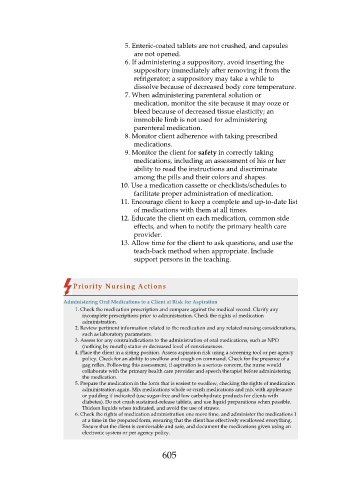Page 605 - Saunders Comprehensive Review For NCLEX-RN
P. 605
5. Enteric-coated tablets are not crushed, and capsules
are not opened.
6. If administering a suppository, avoid inserting the
suppository immediately after removing it from the
refrigerator; a suppository may take a while to
dissolve because of decreased body core temperature.
7. When administering parenteral solution or
medication, monitor the site because it may ooze or
bleed because of decreased tissue elasticity; an
immobile limb is not used for administering
parenteral medication.
8. Monitor client adherence with taking prescribed
medications.
9. Monitor the client for safety in correctly taking
medications, including an assessment of his or her
ability to read the instructions and discriminate
among the pills and their colors and shapes.
10. Use a medication cassette or checklists/schedules to
facilitate proper administration of medication.
11. Encourage client to keep a complete and up-to-date list
of medications with them at all times.
12. Educate the client on each medication, common side
effects, and when to notify the primary health care
provider.
13. Allow time for the client to ask questions, and use the
teach-back method when appropriate. Include
support persons in the teaching.
Priority Nursing Actions
Administering Oral Medications to a Client at Risk for Aspiration
1. Check the medication prescription and compare against the medical record. Clarify any
incomplete prescriptions prior to administration. Check the rights of medication
administration.
2. Review pertinent information related to the medication and any related nursing considerations,
such as laboratory parameters.
3. Assess for any contraindications to the administration of oral medications, such as NPO
(nothing by mouth) status or decreased level of consciousness.
4. Place the client in a sitting position. Assess aspiration risk using a screening tool or per agency
policy. Check for an ability to swallow and cough on command. Check for the presence of a
gag reflex. Following this assessment, if aspiration is a serious concern, the nurse would
collaborate with the primary health care provider and speech therapist before administering
the medication.
5. Prepare the medication in the form that is easiest to swallow, checking the rights of medication
administration again. Mix medications whole or crush medications and mix with applesauce
or pudding if indicated (use sugar-free and low carbohydrate products for clients with
diabetes). Do not crush sustained-release tablets, and use liquid preparations when possible.
Thicken liquids when indicated, and avoid the use of straws.
6. Check the rights of medication administration one more time, and administer the medications 1
at a time in the prepared form, ensuring that the client has effectively swallowed everything.
Ensure that the client is comfortable and safe, and document the medications given using an
electronic system or per agency policy.
605

